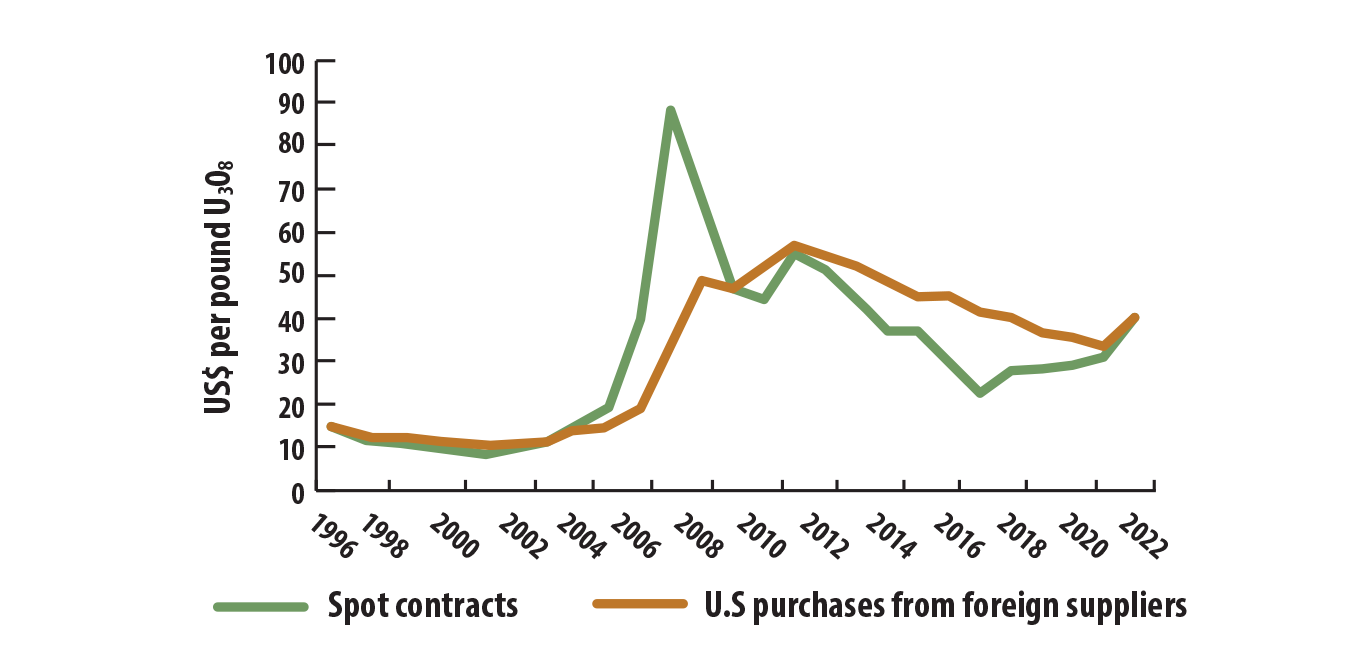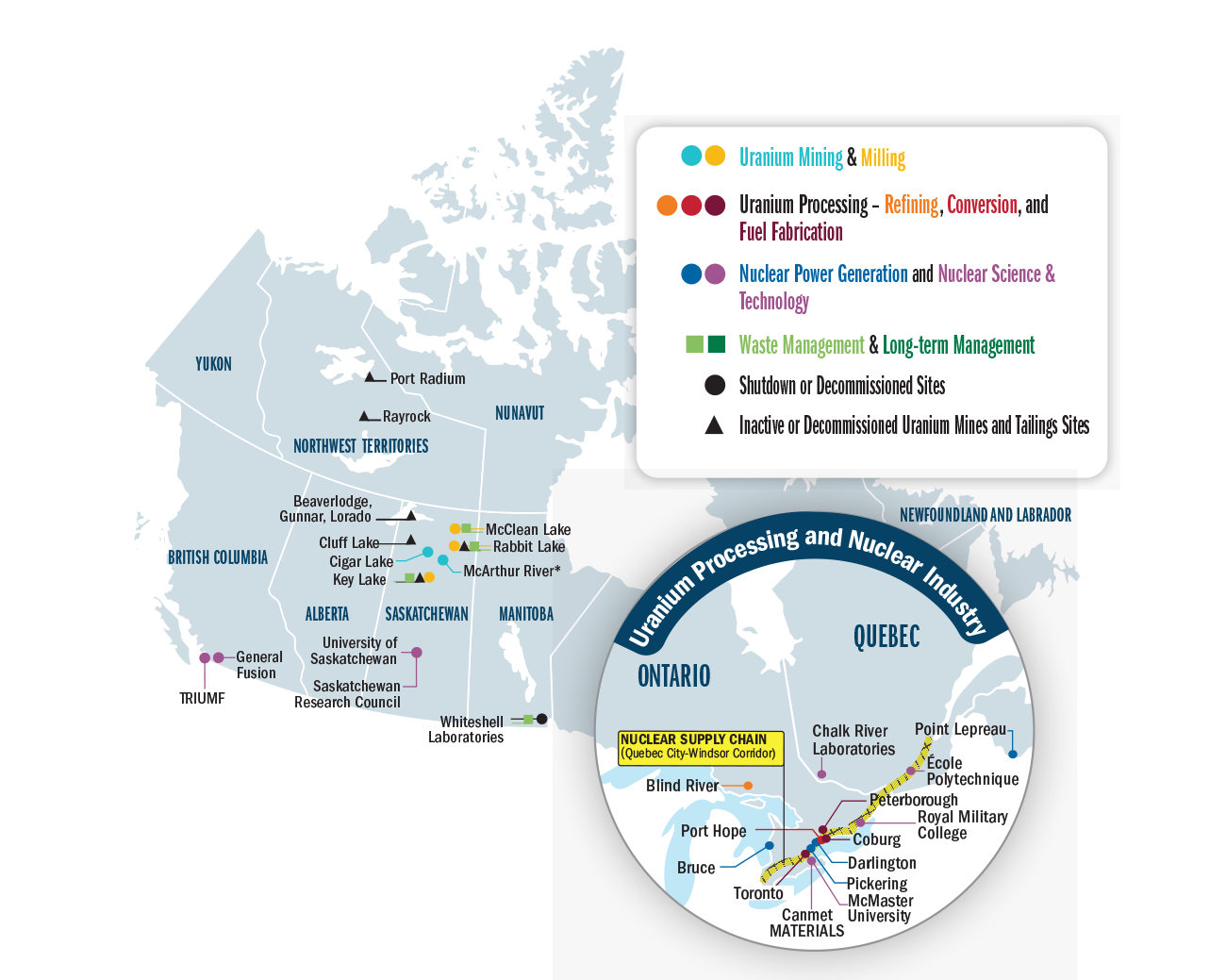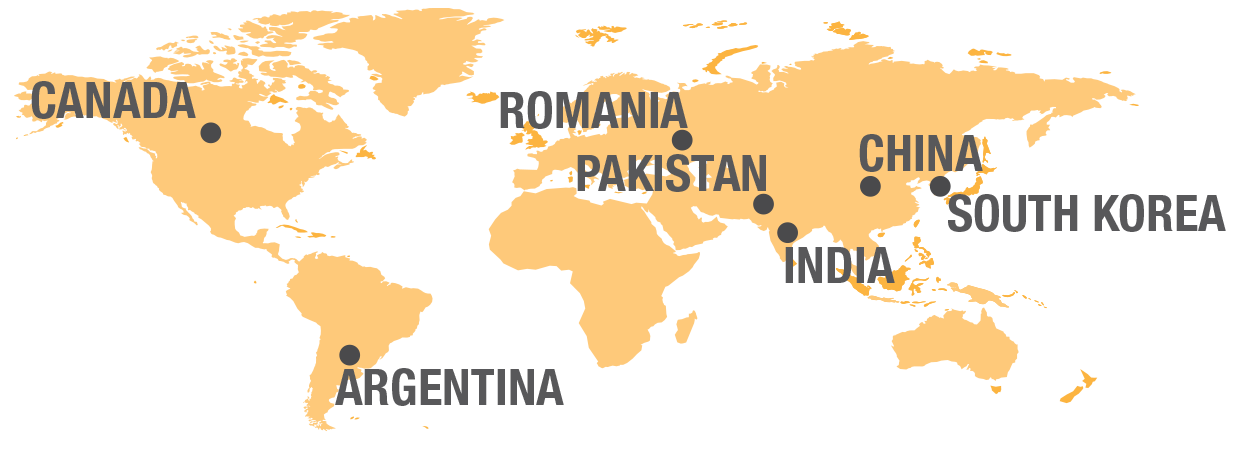
Uranium is a silvery-white metal and a primary energy source. After raw uranium is mined and milled, it is processed to make fuel for nuclear reactors to generate electricity.
Key facts
- Canada is the second largest producer and exporter of uranium in the world, with 15% of global production in 2022.
- Nuclear power generation, which is a source of energy that does not emit greenhouse gases, accounted for approximately 14% of Canada's electricity in 2021.
- Canada has developed a unique nuclear reactor technology, CANDU; there are 18 CANDU reactors in Ontario, 1 in New Brunswick and 11 in operation outside of Canada.
- Under Canada's nuclear non-proliferation policy, Canadian uranium can be used only for peaceful purposes.
- In 2022, 80% of Canada's uranium production was exported for use in nuclear power generation throughout the world.
Learn more about uranium and nuclear power
 Uses and production
Uses and production
Uranium is used primarily to produce fuel for nuclear power plants (more than 99% of the total use). Other uses (less than 1%) include producing fuel for research reactors and medical isotopes.
Canada produced 7.4 kilotonnes of uranium in 2022 from mines in Saskatchewan, which was valued at approximately $1.1 billion.
Key facts
- Canada is the world’s second largest producer and third largest low-cost source of uranium.
- Our resources of more than 588,000 tonnes of elemental uranium (tU) – at a price of less than US$50 per pound for tri-uranium octoxide (U3O8) – supports continued production for at least 50 years.
- All production is from high-grade deposits in Saskatchewan, where the uranium concentrations are up to 100 times larger than the world average.
- Output from the Cigar Lake Mine and the McClean Lake Mill in 2022 was 6,938 tU, ranking this operation as the world’s largest uranium producer.
- Production resumed in November 2022 at the McArthur River mine and Key Lake mill because of increased prices and demand. They had been the world's largest uranium mine and largest uranium mill, respectively, but were suspended in January 2018 because of low uranium prices.
- The Rabbit Lake mine also suspended operations in 2016 because of low uranium prices.
Canadian production of uranium, 2013–2022

Text version
This bar graph shows Canada's annual mine production of uranium from 2013 to 2022. Production increased from 9,332 tonnes in 2013 to a peak of 14,022 tonnes in 2016. Production declined in the following years, reaching a low of 3,878 in 2020 before increasing to 4,747 tonnes in 2021 and 7,380 tonnes in 2022.
Some of the uranium is refined and converted to produce uranium hexafluoride and uranium dioxide in plants in Ontario.
Approximately 80% of Canada's uranium production was available for export. Based on long-term contracts (whose values can vary based on changes in regional demand), Canadian uranium is destined for North America and Latin America (64%), Asia (19%), and Europe (17%). In 2022, 27% of uranium purchased by American nuclear reactors came from Canada, making Canada the largest foreign supplier of uranium to the United States (U.S.).
Domestic use in Canada's CANDU reactors in Ontario and New Brunswick was approximately 20% of production in 2022.
 Supply and demand
Supply and demand
There is a strong nuclear science and technology presence across Canada, including the production of isotopes for medical and industrial applications. All Canadian uranium comes from Saskatchewan, but uranium processing, refining, conversion, fuel fabrication, research, and waste management happens across Canada. Nuclear power stations operate in Ontario and New Brunswick.
 Gross capacity of nuclear power plants in Canada
Gross capacity of nuclear power plants in Canada
The six nuclear power stations in Canada have a combined capacity of 14,629 megawatts. The Bruce generating station in Ontario is one of the largest nuclear power plants in the world.
| Facility | Province | Total capacity (MW) | Units |
|---|---|---|---|
| Darlington | Ontario | 3,736 | 4 |
| Bruce A | Ontario | 3,437 | 4 |
| Bruce B | Ontario | 3,507 | 4 |
| Pickering A | Ontario | 1,084 | 2 |
| Pickering B | Ontario | 2,160 | 4 |
| Point Lepreau | New Brunswick | 705 | 1 |
 International context
International context
Uranium
Find out how Canada's uranium ranks on an international scale:
World production
| Rank | Country | Percentage of Total |
|---|---|---|
| 1 | Kazakhstan | 43% |
| 2 | Canada | 15% |
| 3 | Namibia | 11% |
| 4 | Australia | 8% |
| 5 | Uzbekistan | 7% |
World exports
| Rank | Country | Percentage of Total |
|---|---|---|
| 1 | Kazakhstan | 50% |
| 2 | Canada | 13% |
| 3 | Namibia | 13% |
| 4/td> | Australia | 10% |
| 5 | Uzbekistan | 8% |
World known recoverable resources
| Rank | Country | Percentage of Total |
|---|---|---|
| 1 | Australia | 28% |
| 2 | Kazakhstan | 13% |
| 3 | Canada | 10% |
| 4 | Russia | 8% |
| 5 | Namibia | 8% |
Nuclear power
Find out how Canada's nuclear power ranks on an international scale:
| Rank | Country | Percentage of Total |
|---|---|---|
| 1 | United States | 29% |
| 2 | China | 14% |
| 3 | France | 14% |
| 4 | Russia | 8% |
| 5 | South Korea | 6% |
| 6 | Canada | 3% |
 Prices
Prices
Most Canadian uranium is sold through long-term contracts, as opposed to the spot market. Canadian uranium is generally sold in North America and Latin America (64%), Asia (19%) and Europe (17%).
The average spot contract price for uranium declined from a peak of $88 per pound U308 equivalent in 2007 to $22 in 2017 and has gradually increased to $41 in 2022. In 2022, the value of spot contracts surpassed the value of purchases from foreign suppliers ($40) for the first time since 2008.
Uranium Prices, 1996–2022

Text version
This line chart shows the weighted-average price of uranium purchased from foreign suppliers and spot contracts (U308) in U.S. dollars per pound from 1996 to 2022.
The average uranium spot contract price declined from a peak of $88 per pound U308 equivalent in 2007 to $22 in 2017 and gradually increased to $41 in 2022. In 2022, the value of spot contracts surpassed the value of purchases from foreign suppliers ($40) for the first time since 2008.
 Canadian nuclear research and development
Canadian nuclear research and development
Canada has nuclear research and development capabilities that are supported by academic research centres, the private sector and government laboratories—including Chalk River Laboratories, Canada's largest science and technology complex.
Nuclear energy research is focused on supporting existing reactor technologies as well as next-generation nuclear energy systems. Canada is also a leader in nuclear R&D for areas such as nuclear medicine, pharmacology, environmental protection and wastewater treatment.
Small modular reactors (SMRs) are nuclear reactors that operate at a smaller scale than current nuclear power plants. Although not yet commercially proven in Canada, they may have future applications. SMRs might replace fossil fuel power plants or be used as load-following units equipped with systems for storing excess electricity to complement larger shares of variable renewables.
SMRs may also have applications in the production of heat and electricity at both on- and off-grid industrial sites, and to help off-grid northern and remote communities reduce their reliance on diesel.
 CANDU nuclear reactors
CANDU nuclear reactors
Canada has developed a unique nuclear reactor technology called CANDU and is one of roughly half a dozen countries that offer domestic-designed reactors to the open commercial market.
In addition to Canada, CANDU reactors have been sold to India, Pakistan, Argentina, South Korea, Romania and China.
CANDU technology continues to evolve to enable the use of alternative fuels. Work is under way in Chinese CANDU reactors to demonstrate that they can recycle used fuel from other nuclear power plants, reducing the volume of nuclear waste.
Learn more about Canadian Nuclear Energy Technology.
Find out more about minerals and metals facts
Notes and sources
All amounts are in Canadian dollars unless indicated otherwise.
- Supply and demand
- Cameco, 2022 Annual Report; World Nuclear Association, "Uranium in Canada"
- Gross capacity of nuclear power plants in Canada
- International Atomic Energy Association, "Power Reactor Information System"
- International context
- World production: World Nuclear Association "World Uranium Mining"
- World exports: Natural Resources Canada estimate based on the World Nuclear Association, "World Uranium Mining Production" and "World Nuclear Power Reactors & Uranium Requirements"
- World known recoverable resources:: Organization for Economic Co-operation and Development Nuclear Energy Agency; the International Atomic Energy Agency, Uranium 2022: Resources, Production and Demand
- Prices
- United States Energy Information Administration, Uranium Marketing Annual Report (2022 Edition)
- Canadian nuclear research and development, CANDU reactors
- Based on figures compiled by Natural Resources Canada
- Nuclear power
- World generation:: International Atomic Energy Agency, Nuclear Power Reactors in the World (2022 Edition)

